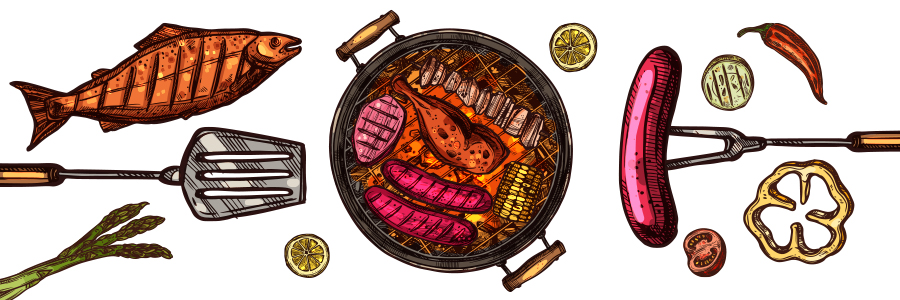


Sign-up for {N}power to get exclusive discounts, newsletters, members-only features, and more!

Nothing says summer like a backyard barbeque! However, cooking certain foods over high heat, like that of a grill, can actually create dangerous compounds—compounds that are associated with cancer, heart disease, diabetes, and Alzheimer’s. But don’t cancel the party just yet! With a little knowledge and careful preparation, you can greatly reduce the formation of these compounds, and with an arsenal of antioxidant-rich foods, you can protect yourself even further.

Hetero-what and polycyclic-who? Heterocyclic amines (HCAs) are chemicals formed when certain amino acids and sugars (both naturally occurring in meat) react together when exposed to high temperatures. Polycyclic aromatic hydrocarbons (PAHs) are present in emissions from wood and coal burning, automobiles, tobacco smoke, and in many foods. In grilling, they are formed when fats from the meat drip down into the open fire, causing PAHs from the flames to adhere to the meat’s surface. Both HCAs and PAHs bind to DNA, with the potential to cause mutations and changes, a major step in the process that ultimately leads to tumor formation. HCAs are on the National Institutes of Health’s list of known carcinogens.
AGEs are created when proteins and fats react with sugar when exposed to high heat. It is this reaction that creates the char on a steak, the browning of toast, and the singe on roasted marshmallows. Cooking techniques such as toasting, charring, and grilling are recognized for enhancing the flavor of foods and are often favored over healthier methods. The problem is that this reaction between sugar and protein doesn’t just change the color and taste of food, it also creates AGEs, which can be toxic. In the body, they cause damage to tissue and organs by binding to cellular receptors known as RAGEs (receptors of AGEs), which promote low-level inflammation. They also link with proteins in cells, causing permanent damage to the cellular structure and altering their function. They are also associated with a host of diseases, including type-2 diabetes, cardiovascular disease, Alzheimer’s disease, allergies and autoimmune diseases, cancers, gastrointestinal diseases, and even kidney failure. AGEs are also created in the body when excess blood glucose binds with proteins. When you think of AGEs, think “aging” because that is exactly what they do to the body.
It’s important to know that grilling is not the only cooking method that creates toxic compounds. Fried, smoked, and processed meats are all high in these dangerous compounds. In fact, it may be the cooking and processing methods of these meats that have earned them their unhealthy reputation, not the meat itself. The best bet is to stick to a diet high in natural and unprocessed foods, and when you do use a cooking technique like grilling, be sure to follow a few preparation techniques that will greatly reduce the formation of these damaging compounds.
There are many antioxidant-rich foods that will help to protect your body from the dangerous effects of these chemicals. Nearly all veggies and fruits are rich sources of antioxidants and have a proven track record of protecting cells from the types of DNA damage caused by HCAs and PAHs. Serve lots of vegetables, especially cruciferous veggies like cabbage (coleslaw!) or broccoli, alongside your grilled meat, and serve a large fruit salad or grilled fruit for dessert. Veggies are also not vulnerable to the formation of these dangerous compounds, so load up the grill with kabobs skewered with button mushrooms, red onions, colorful bell peppers, and zucchini. Fill a grill tray with tender asparagus and thinly sliced lemon. Throw some marinated portabella mushrooms or thick slices of eggplant on the grill for a veggie style “steak.” Experiment with different veggies.
For even more protection, incorporate nature’s heavy hitters into your grilling—certain foods and spices have a big impact on preventing the formation of HCAs, PAHs, and AGEs. For example, when cherries are added to ground beef used to make hamburgers, the burgers contain only 10 percent of the HCAs normally found in a burger. A simple and highly effective way to reduce the formation of HCAs in your grilled meats is to add a little vitamin E directly to ground meat, or apply it to the surface of larger cuts. It doesn’t take much either—all you need is one 400 IU capsule of natural vitamin E (d-alpha tocopherol) to treat 10 pounds of hamburger. The flavonoids found in citrus can significantly reduce the formation of HCAs and help prevent PAHs from adhering to meat; try adding citrus juices to marinades. The Lactobacilli strains in yogurt have been shown to neutralize HCAs in the gut, preventing them from damaging DNA. Serve a yogurt-based sauce with your grilled meat or even yogurt and fruit for dessert. Nearly all spices offer antioxidant protection—turmeric, rosemary, ginger, paprika, oregano, cinnamon, and garlic powder are all good choices—and they can easily be added to rubs or marinades. While all of these additions are potent protectors for our bodies, they are also delicious and actually enhance the taste of the foods you are grilling.
Don’t let HCAs, PAHs, and AGEs ruin your summer barbeques. Make this summer the summer of conscious grilling by following some simple healthy preparation tips, building your antioxidant arsenal for extra protection, and experimenting with different foods to get the most out of grilling season!



Sign-up for {N}power to get exclusive discounts, newsletters, members-only features, and more!